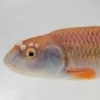Found 2 Huge Umbra Limi today.
Started by
Guest_tglassburner_*
, Dec 08 2013 12:22 AM
11 replies to this topic
#2

Posted 08 December 2013 - 12:42 PM
Tom it looks like you tried to link us to a picture that we cannot access... I even tried copying the link you provided and going there direct... got an access forbidden kind of message.
Either write something worth reading or do something worth writing. - Benjamin Franklin
#6
 Guest_tglassburner_*
Guest_tglassburner_*
Posted 08 December 2013 - 05:12 PM
Also I cannot imagine that these larger fish are specifically male as I was told yesterday because that would mean in all the 100s of mudminnows I've collected and or seen that there were only 2 males found. Why would there be the need to grow this large in a population of smaller adults? Either way come spring they are going in my pond, where they will hopefully eventually breed wth the other mudminnows and have giant offspring! Photo does not do them justice. They are over 5" each.
Edited by tglassburner, 08 December 2013 - 05:12 PM.
#9
 Guest_butch_*
Guest_butch_*
Posted 08 December 2013 - 07:15 PM
Maybe it has do with their age related to their size? In most populations of fish in general, there is always a giant or two in each population. I can't tell you how many giants I've found in different species. Seen few giant gambusia, included a giant male that is same size as their female counterpart, a thick 4" male fathead minnow, a 12" common shiner, a 12" stoneroller, a 6" orange spotted sunfish and few 4" brook sticklebacks that you can use them for pike bait.
#11
 Guest_Uland_*
Guest_Uland_*
Posted 10 December 2013 - 08:08 PM
Tom,
Looks like you found a solid large U limi.
In some locations I sample, sporadic juveniles are to be found and you'll even see adults in nuptial condition at 3.5". I also sample locations where they are the most abundant fish to be found. In both of these situations, you'll find large 5"~6" fish if you dig hard enough. Naturally your odds increase if you're in a location where they are abundant.
I find very large adults are easiest to find immediately after the ice breaks (March in Northern Illinois) in less than 4" of water in heavy vegetation. Many specimens are quite ragged and possibly near death.
Looks like you found a solid large U limi.
In some locations I sample, sporadic juveniles are to be found and you'll even see adults in nuptial condition at 3.5". I also sample locations where they are the most abundant fish to be found. In both of these situations, you'll find large 5"~6" fish if you dig hard enough. Naturally your odds increase if you're in a location where they are abundant.
I find very large adults are easiest to find immediately after the ice breaks (March in Northern Illinois) in less than 4" of water in heavy vegetation. Many specimens are quite ragged and possibly near death.
Reply to this topic
1 user(s) are reading this topic
0 members, 1 guests, 0 anonymous users












